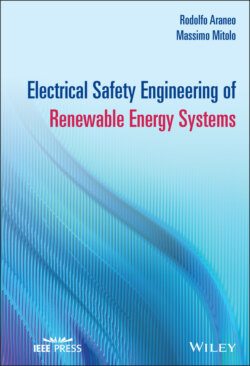Читать книгу Electrical Safety Engineering of Renewable Energy Systems - Rodolfo Araneo - Страница 14
1.2.1 Ventricular Fibrillation
ОглавлениеThe ventricular fibrillation (V-fib) [11] is the loss of the normal heart rhythm. The V-fib causes the ventricles to quiver, or fibrillate, instead of contracting normally, preventing the heart from pumping blood and causing cardiac arrest. The ventricular fibrillation is the main cause of death in electric shock accidents.
The cardiac muscle, whose fibers have high contractile strength, specializes in pumping blood throughout the person’s body. The contractions of the heart are stimulated by the sinoatrial node (SA), situated in the right atrium, which generates electrical impulses. The impulses propagate through the conductive tissues named Bundle of His, and Purkinje fibers, and reach the atrioventricular node (AV), situated in the center of the heart (Figure 1.1).
Figure 1.1 Electric conduction of the heart.
The Bundle of His, which departs from the AV, conducts the stimuli to the ventricles, which, after filling with blood, contract and push the blood through the arteries during the systole. After the contraction, the heart relaxes and fills up with blood again, awaiting further stimuli to contract again.
The net charge of the heart is zero; however, positive and negative charges are dynamically separated during each cardiac cycle and form an electric dipole vector that rotates and varies in magnitude with time. Thus, electric potential differences at different places along the person’s body also change with time during each cardiac cycle, and this can be observed in an electrocardiogram (i.e., EKG or ECG) (Figure 1.2). Usually, scalar EKG measurements are performed: vector EKGs, which may more deeply describe the heart dipole rotation, are rarely performed. Typical potential differences showed in the EKG range between 30 and 500 µV.
Figure 1.2 A normal electrocardiogram (EKG).
During the P wave, the right and left atria contract; during the Q-R-S complex, the right and left ventricles contract (systole). The last event of the cycle, the S-T-U interval, is the repolarization of the ventricles: they return to the resting state; their walls relax and await the next signal. This complex procedure continues as the atria refill with blood and more electrical signals are sent by the SA; the heart-period duration is around 400 ms.
The superposition of external currents of larger magnitude to the normal bodily currents will override the control signals from the brain to the skeletal and cardiac muscles, which can no longer operate as intended, exposing persons to the risk of death.
The last half of the T wave is referred to as the relative refractory period, or the vulnerable period, which is known as the crucial time interval during which external electrical stimuli (i.e., electric shock) may induce the ventricular fibrillation.
For shock durations shorter than the cardiac cycle, the ventricular fibrillation may not occur, based on the lower probability that the external stimulus occurs during the vulnerable period of the heart.
For d.c. currents, experiments on animals and data derived from electrical accidents demonstrate that the threshold of V-fib for a downward current is about twice as high as for an upward current; therefore, downward currents are less hazardous than upward currents.
For shock durations longer than the cardiac cycle (e.g., 0.5-1 s), the threshold of fibrillation for d.c. is several times higher than for a.c. However, for shock durations shorter than 200 ms, the threshold of d.c. fibrillation is approximately the same as for a.c. (measured in r.m.s. values).
